Sheet glass is a versatile glass characterised by its flat,thin, and uniform appearance. Due to its smooth and distortion-free surface,sheet glass is suitable for various applications in architecture, construction,automotive, and numerous industrial sectors.
This versatility makes sheet glass perfect for buildings' windows, doors, and facades to windshields and windows in vehicles. Join us, a trusted glass company in Auckland, as we go behind the scenes to uncover how sheet glass is made. This guide will help you understand the complexities behind this fascinating material used in everyday life.
Typically, sheet glass comprises sand, soda ash (sodium carbonate), and limestone, often blended with small amounts of other additives for specific properties.
Sand: High-quality silica sand is the primary ingredient, providing the glass's basic structure and clarity. It's sourced from deposits or quarries and requires cleaning and refining to remove impurities.
Soda Ash (Sodium Carbonate): Thismaterial acts as a flux, lowering the melting point of the mixture. It also contributes to the glass's stability and durability. Soda ash is obtained through the mining of trona ore or chemical processes.
Limestone: Calcium carbonate, derived from limestone, aids in stabilising the glass and preventing its reaction with atmospheric moisture over time. Limestone is usually sourced from quarries.
The glass may include other additives, such as dolomite orcullet (recycled glass shards). Precise blending of these raw materials iscritical, as it determines the glass's chemical composition, transparency,strength, and other properties.
The furnace is the heart of glass manufacturing, transforming raw materials into molten glass. It operates at extremely high temperatures, typically exceeding 1,500°C (2,732°F). The raw materials are carefully measured and fed into the melting tank, where they combine and undergo a series of chemical reactions. These reactions fuse the raw materials into a homogeneous liquid mass. Impurities and gases are released during this process and carefully managed to ensure the glass's desired quality.
The molten glass liquid then exits the furnace and is gently poured onto a bath of molten tin, also known as the float glass technique. The tin's characteristics prevent the glass from mixing with it, creating a uniform surface with minimal distortions. The continuous glass ribbon is then guided through controlled cooling processes to stabilise it further and prevent internal stresses. The process creates a perfectly flat and smooth glass sheet, the basis for many glass applications today.
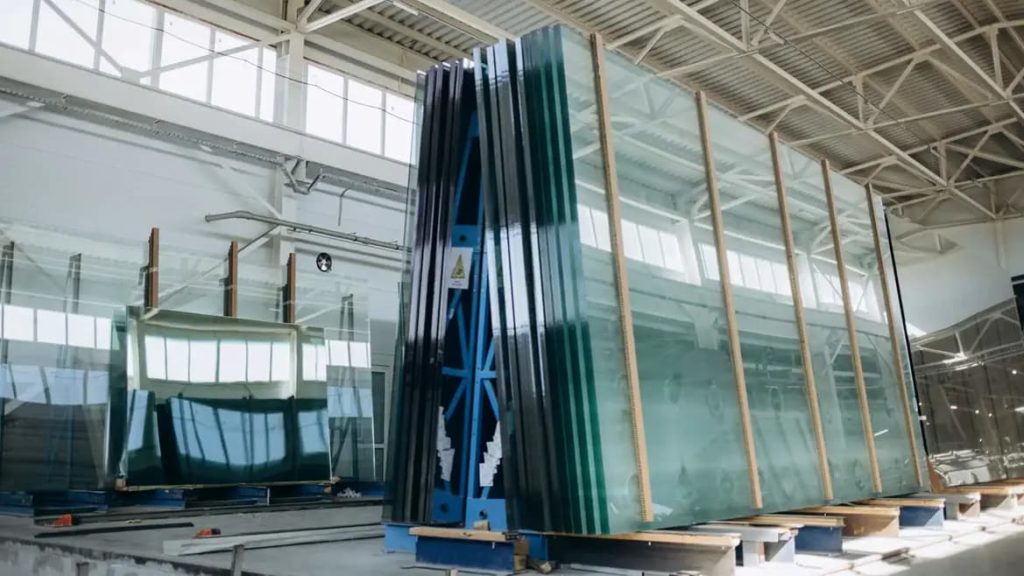
Cutting is crucial in shaping sheet glass into desired dimensions for application. There are various methods of cutting sheet glass, such as:
Manual Cutting: Skilledglassworkers use tools like diamond-tipped cutters to score the glass along thedesired cutting line. The glass is then gently broken along the score line.
Mechanical Cutting: Automated machines equipped with diamond or carbide cutting wheels can precisely cut sheets of glass according to programmed dimensions.
Laser Cutting: Advanced laser technology can make intricate and precise cuts on glass surfaces.
Once cut, the glass undergoes rigorous quality control to identify and address defects. Defective pieces with imperfections such as air bubbles, chips, scratches, or variations in thickness are rejected to maintain the highest quality standards. In some cases, if only a portion of a sheet has defects, salvageable sections are cut out from the defective parts, helping minimise waste and maximise the utility of the glass. The remaining sections, if not salvageable, are usually recycled.
Depending on the desired effect, glaziers can configure your sheet glass into different specialised types. For example, Low-E glass is created by applying a thin, transparent coating typically made of metal or metal oxide layers to the surface. The coating reflects infrared (heat)radiation while visible light can still pass through. Laminated glass is created by sandwiching a layer of plastic (usually polyvinyl butyral) between two or more layers of glass. After forming the glass layers, they are assembled with the interlayer and then heated and pressed under high pressure, creating a glass product with enhanced safety and security properties.
Specialised glass types require distinct processing steps to achieve their unique properties. These steps typically occur post-sheet glass formation, tailoring the glass for specific applications such as energy efficiency, solar control, privacy, or safety.
Located in West Auckland, our glaziers are some of New Zealand’s best! From premium float glass to toughened safety glass units, we produce high-quality glass and glazing solutions in-house, perfect for all your project needs and requirements. To learn more about our glass products and range of services, don't hesitate to contact our friendly team today!
Light exposure is essential to happiness, emotional health, and overall wellbeing. Before the invention of glass, the earliest windows comprised simple openings in roofs that admitted light during the day before progressing to include animal hide, cloth, or wood coverings. These protected the inhabitants from weather elements while being translucent, allowing trace elements of light to illuminate homes. Learn more about how glass has been used through the years as we explore the history of glass windows.
The first glass creations were found in nature. Naturally occurring volcanic glass, or obsidian, was used to fashion basic ornaments and spear tip weapons or serve as forms of currency in the prehistoric age. The first existence of man-made glass can be traced back to 3500 BC.
Glass is manufactured from natural raw materials like sand, soda ash, and limestone that are melted at high temperatures to form a liquid. It is then manipulated and moulded into different shapes before cooling into hardened glass structures. The introduction of the blowpipe was pivotal in the construction of glass containers. However, the glass produced in this period contained a high level of impurities and was mostly used for fashioning jewellery and vessels. Glass windows had not yet been invented.
The history of the first glass windows began by the end of the 1st century AD, as glass material became commonly available throughout the Roman Empire. The Romans were the first to make window glass panes. Blown cylindrical shapes were flattened out into thinner sheets, serving as the building pieces for window creations. However, this manufacturing process meant that windows were limited to a small size of uneven thickness and weren’t completely transparent.
Stained glass gained popularity across Europe as Christianity spread in the 4th century and was used to create biblical images by joining different coloured pieces of glass together.
The history of glass windows and innovative experiments have culminated in the revolutionary window-making techniques we use today. The float glass-making process was introduced in the 20th century and remains the industry standard for making glass windows. Molten liquid glass is poured and spread out on a bed of molten tin, paving the way for large panes of unblemished glass devoid of flaws to be created.
Today, we see many innovative window glass variations like retrofit double glazing and tinting, together with different framing choices that you can customise to suit your home and the climate.
Enjoy the many benefits of modern technology and innovation with Atlas Glass, Auckland’s double-glazing experts. Retrofit double-glazing features two or more panes of glass spaced and hermetically sealed, creating a layer of air in the middle. A high-quality and attractive window solution, this method provides insulating qualities for an energy-efficient home with cost-effective minimal maintenance. Talk to our experienced team for a free consultation and advice on how retrofit double-glazed windows can work for your home today!
If you think that modern glass is only used for practical residential and commercial applications, then you might be pleasantly surprised to find out it’s also used as an art form. We scouted around the globe in search of some of the best glass sculptures, so sit back and let us take you through our favourites!
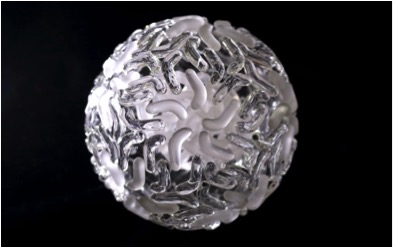
One of the most interesting pieces of glass art comes from Luke Jerram. Since 2004, the artist has been turning viruses and minuscule pathogens into unique and otherworldly glass sculptures. His concept of sculpting something that is usually invisible to the naked eye has brought an entirely new dimension to the layman’s understanding of your average bacteriophage. It’s one thing to read about these types of viruses, but it’s another thing entirely to see what they actually look like! Who knew these deadly bacteria had unnatural shapes with sharp, weapon-like edges. From representations of swine flu to Ebola, Jerram’s made-to-scale glass sculptures are spine-tingling, yet very original!
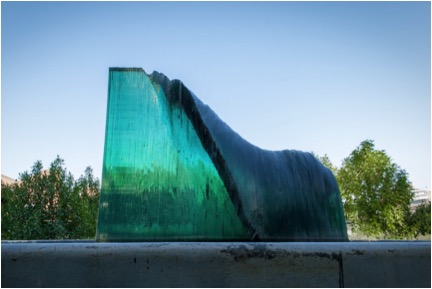
Sergio Redegalli is the creative mind behind Cascade – a glass sculpture displayed in the Adelaide Botanic Garden. In 1988 he was commissioned to provide a piece for the World Expo being held in Brisbane at the time, with the theme of “Leisure in the Age of Technology”. Taking an interesting view of this theme, Redegalli produced a sculpture that would have been nearly impossible without the aid of technology, which symbolises the leisurely fall of a wave. The astonishing 12-ton glass sculpture has 500 precision-cut pieces of 6mm clear glass, all glued together to create the illusion of a cascading wave.
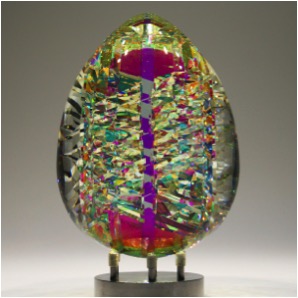
Jack Storms is one of the more contemporary artists who has already made his mark in the history books of glass artistry. Inspired by the Fibonacci principle, he has developed an incredibly rare type of glass artwork that takes 24 labour-intensive weeks to complete. The process includes cutting a core of lead crystal, then polishing and laminating it to create reflective mirrors. It is then wrapped in optical glass to create a rainbow-colour effect when light passes through. It then goes through hours and hours of repetitive grinding, cutting, and polishing to create the smooth end result you see above. Because of his incredibly unique work, his glass art has been commissioned for the President of Nigeria, while two of his glass artworks also appeared in the hit Marvel franchise film “Guardians of the Galaxy”.
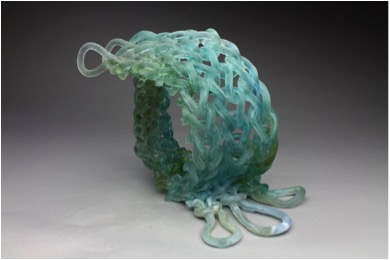
Carol Milne is famous for her unique and intricate Knitted Glasswork. It was in 2006 that she discovered her fascination for knitting, mould-making, and kiln-casting, and by combining these she created the award-winning Knitted Glass. Her work claimed the Silver Award at the 2010 International Exhibition of Glass in Kanazawa, Japan. Her work is absolutely fascinating; by creating the traditional looping patterns of a knitted piece with melting glass, she has created something entirely unseen in the modern world of glass work. She has said that her work is inspired by the image of society. “I see my knitted work as a metaphor for social structure. Individual strands are weak and brittle on their own, but deceptively strong when bound together.”
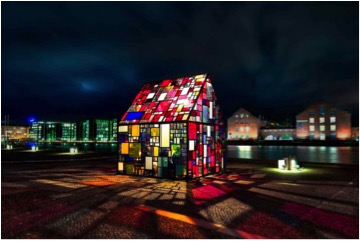
Not exactly an entirely glass sculpture, but this work deserves a spot on our list: Kolonihavehus by Brooklyn-based artist, Tom Fruin. The work is an installation made from 1000 pieces of salvaged plexiglass and scrap metal, which have been reworked into a colourful glass house with indoor lighting. As a “3D evolution” of his previous work with salvaged drug-bags, his work proves that you can still make something great and beautiful even from scrap. Truly, one man’s trash is treasure to another. Tom Fruin’s work is now exhibiting in Brooklyn Bridge Park in New York.
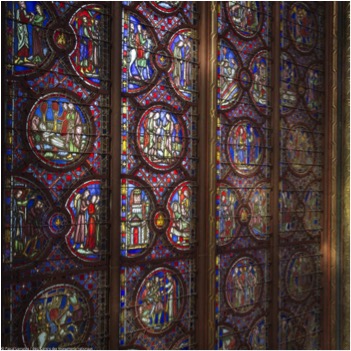
One of the best-preserved medieval masterpieces in Europe is the Sainte-Chapelle. It’s located in the Palais de la Cité, the old royal palace of the kings and queens of France. The chapel’s window design is one of the city’s highlights, and is regarded as a glorious masterwork that transcends time. You wouldn’t have guessed that it was made in the 1240s, as its stained-glass windows are intricately made to depict biblical, local, and political stories. With 15 panes standing at 15 metres high each, these beloved moments in history are truly a sight to behold. There are 1,130 biblical figures depicted in the glass spread over its huge windows, and one large rose window. It is a true testament to the beauty that will result from dedicated time, energy, and belief in a greater idea.
Glass windows are a versatile instrument that can be used for religious ornamentation, an art form, or your home’s ventilation and insulation! At Atlas Glass, we make sure to provide only the best glazing services to complete your stunning home. We are experiencedAuckland glaziers who can take care of your home’s retrofit double glazing and timber joinery glazing for a home you can call your functional piece of art. Contact us to learn more.